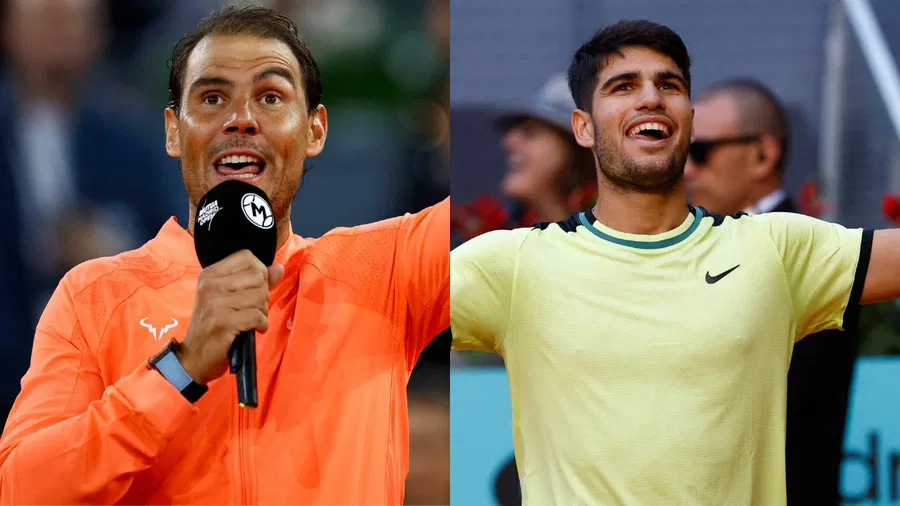Breaking: Carlos Alcaraz Channels Rafael Nadal’s Superstitions While Unveiling the Truth Behind His New Addition
In a thrilling twist that has sent shockwaves across the tennis world, Spain’s rising tennis star, Carlos Alcaraz, has recently revealed how he’s been influenced by his fellow countryman, Rafael Nadal, when it comes to certain superstitions – giving us an intriguing look into the psychological side of tennis that fans have long been curious about. This revelation comes as Alcaraz introduces a surprising new addition to his playing gear, sparking discussions on everything from his mental game to the ongoing rivalry with the sport’s legend.
The news broke during an intimate interview following his recent victory at the [insert tournament name], where Alcaraz was asked about the secret behind his mental strength and competitive edge. The 20-year-old sensation, who is known for his dynamic playing style and calm demeanor under pressure, opened up about the deep-seated rituals that play an unseen role in his career.
Alcaraz, much like Nadal, has been seen incorporating an almost ritualistic approach to his tennis routine, focusing on details and habits that might seem trivial to the untrained eye but hold significant psychological value for elite athletes. The revelation? Alcaraz has been channeling some of Nadal’s famous superstitions, even adopting a few of the practices that have long defined the 22-time Grand Slam champion’s approach to the sport.

Rafael Nadal is renowned not only for his incredible athleticism but also for his strict adherence to routines. From the meticulous placement of his water bottles to his ritualistic way of bouncing the ball before each serve, Nadal’s superstitions have become a cornerstone of his identity on the court. For many years, fans have speculated about the mental significance behind these habits, with some suggesting that they provide Nadal with a sense of control over the uncontrollable chaos of a tennis match.
Now, in an unexpected turn, Alcaraz has admitted that he too follows similar patterns. “I’ve always admired Rafa’s mental strength and the way he deals with pressure,” said Alcaraz. “His rituals and routines bring a calmness that I have tried to incorporate into my own game. It’s not about being superstitious in the traditional sense, but more about finding a personal rhythm that works for me.”
The most notable new addition that has sparked conversation is Alcaraz’s decision to introduce a new type of lucky charm—something he describes as “his own version of Rafa’s water bottle ritual.” Alcaraz has started placing a small talisman at the edge of the court during important matches, a gesture he admits he began after seeing Nadal’s unwavering commitment to his superstitions over the years. The talisman is a small, custom-made bracelet, designed with a symbol that represents balance and focus, and it has quickly become part of his pre-match routine.
This revelation has undoubtedly caught the attention of fans and analysts alike, who have always drawn comparisons between the two Spaniards. Alcaraz’s meteoric rise in the sport has already seen him rack up impressive titles, but this personal connection to Nadal, in terms of both playing style and mental habits, has sparked renewed interest in the young star’s psyche.
What many may not know is that Alcaraz’s decision to embrace these superstitions wasn’t made on a whim. The young athlete explained that the inclusion of the bracelet was part of a deliberate strategy to bring focus to his game during high-stakes moments. “In tennis, you face constant distractions, whether it’s the crowd, the pressure, or your own self-doubt,” Alcaraz shared. “Having that one little piece of something that you can rely on gives you the mental edge. Rafa has done it for years, and I think it works.”
While it might seem like a small gesture, athletes in high-pressure environments often lean heavily on rituals and superstitions as ways to create mental stability and fortify themselves against external pressures. In a sport as mentally taxing as tennis, it’s not just physical prowess that determines success—it’s the ability to maintain calm and focus under intense scrutiny.
Alcaraz’s decision to reveal this new addition comes at a fascinating time in his career. After a challenging but rewarding 2024 season, where he solidified his position as one of the sport’s brightest stars, his openness about embracing superstition shows a deeper layer to his approach. He’s not only looking to emulate Nadal’s tennis technique but also his mindset, which is perhaps the most crucial element in a sport that requires both mental and physical resilience.
The relationship between Alcaraz and Nadal has always been one of admiration and respect. While their rivalry is still in its infancy, Alcaraz has made it clear that he views Nadal as a source of inspiration, not just for his tennis skill but for his approach to life as a professional athlete. Alcaraz continues to break records, and as his game evolves, it’s clear that he’s crafting a unique legacy while also incorporating elements from the best players in history.
As for the future, the young Spaniard is now in a fascinating position: combining his own talent with the wisdom of tennis legends. The addition of a new superstition could be just the beginning of a trend that fans and experts alike will be watching closely. Alcaraz is rapidly proving that he’s not just the future of tennis—he’s a dynamic force who is embracing every tool at his disposal, including the power of mental rituals, to become the very best.
In the coming months, it will be exciting to see how this superstition might evolve and how the young star’s game progresses. As Alcaraz continues to rise, one thing is for certain: his journey is only beginning, and he may just be following in Nadal’s footsteps in more ways than we originally thought.
Stay tuned for more updates as Carlos Alcaraz takes the tennis world by storm—and as he continues to balance superstition and superstardom with the utmost skill.
Leave a Reply